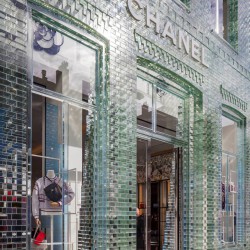
MVRDV . photos: © Scagliola/Brakkee
The entirely transparent façade of a new boutique store on Amsterdam’s upmarket shopping street, PC Hooftstraat, uses glass bricks, glass windows frames and glass architraves in a way to evoke the vernacular of the area with the goal to maintain the character of the site. The 620 m2 of retail and 220 m2 of housing, were designed for investor Warenar. The design unites the ambition of Amsterdam to have large distinctive flagship stores without compromising the historical ensemble. The project, conceptualised by MVRDV, was developed and constructed as part of a multi-team collaboration including Gietermans & Van Dijk Architects, Delft University of Technology, Brouwer & Kok engineers, ABT consulting engineers, Poesia (brand of Vetreria Resanese) glass manufacturers from Italy and contractor Wessels Zeist.
_
The design hopes to provide a solution to the loss of local character in shopping areas around the world. The increased globalisation of retail has led to the homogenisation of high-end shopping streets. Crystal Houses offer the store a window surface that contemporary stores need, whilst maintaining architectural character and individuality, resulting in a flagship store that hopes to stand out amongst the rest.
After conceiving the initial idea MVRDV worked closely with a number of partners to develop the technologies to make it possible. Solid glass bricks were individually cast and crafted by Poesia in Resana, near Venice. Research undertaken by the Delft University of Technology, in partnership with engineering firm ABT and contractor Wessels Zeist, led to the development of structural solutions and fabrication techniques, with the use of a high-strength, UV bonded, transparent adhesive from Delo Industrial Adhesives in Germany to cement the bricks together without the need for a more traditional mortar.
Six to ten experts worked every day for a whole year in a place that bore more resemblance to a laboratory than a construction site. Due to the sensitivity of the materials, an extremely high level of accuracy and craftsmanship was required and a technical development team was onsite throughout the process. Since this construction is the first of its kind, new construction methods and tools had to be utilised: from high-tech lasers and laboratory grade UV-lamps, to slightly lower-tech Dutch full-fat milk, which, with its low transparency, proved to be an ideal liquid to function as a reflective surface for the levelling of the first layer of bricks. Despite its delicate looks, strength tests by the Delft University of Technology team proved that the glass-construction was in many ways stronger than concrete. The full-glass architrave, for instance, could withstand a force of up to 42.000 Newton; the equivalent to two full-sized SUVs.
The development of new construction methods unearthed additional possibilities for future building, such as the minimisation of waste materials. In essence, all of the glass components are completely recyclable. Waste materials from the project, such as imperfect bricks, could simply be (and were) melted down and re-moulded or entirely repurposed. Such is also true for the entire façade itself, once the building has reached the end of its life span, the whole facade can be melted down and given a new life. The only exceptions to this rule are added features which ensure the security of the building, such as a concrete ram-raid defence plinth, hidden in a blend of reflective and translucent materials and built to withstand the force of a car crashing into the building. Repair-protocols were developed in the event of any damage, allowing for the replacement of individual bricks.
With a façade made primarily out of glass it was important to ensure that energy requirements were supplied through renewable sources. Therefore, the building was designed around a ground source heat pump, its pipes leading up to 170 metres underground, allowing for an optimal indoor climate throughout the year. A crucial element when dealing with delicate, sophisticated detailing while striving for a proper energy balance at the same time.
The store is currently operated by French fashion house Chanel which will return later to their previous location on the PC Hooftstraat, also owned by Warenar. MVRDV worked in close partnership with professors and PhD researchers from the Delft University of Technology, alongside engineering firm ABT, with special mention going to Fred Veer, Rob Nijsse, Faidra Oikonomopoulou, Telesilla Bristogianni and Kees Baardolf. Poesia developed and manufactured the glass bricks, whilst Gietermans & van Dijk aided in the architectural design of the project. Also involved in the development and construction of the project were structural engineers Brouwer & Kok and contractor Wessels Zeist, of whom the brothers Van de Poppe played a vital role in the innovation of the adhesive and the glass brick laying on site. Energy conservation and renewable energy experts CCS Energy Advice aided with the development of sustainable solutions and energy production. Contributors to glass elements include Siko who supplied several types of the Delo adhesives and advised how to apply them, Cura Glass for the doors and Van Tetterode Glass Studio.
_
Design Team:
Winy Maas, Jacob van Rijs and Nathalie de Vries with Gijs Walker, Mick van Gemert and Renske van der Stoep
Co-Architect:
Watering Mans & Van Dijk Wim watering Mans, Arjan Bakker, Tuğrul Avuçlu
Manufacturer glass bricks:
Poetry (brand of glassware Resanese): Ivano Massarotto
Importer of Delo glue:
Siko: Rob Janssen
Contractor:
Wessels Zeist: Robert van der Hoeven, Richard of Ende, Marco and Ronald of the Dolls
Constructor:
Brouwer&Kok: Paul Brouwer
ABT: Rob Nijsse
Research:
Delft University of Technology: Frederic A. Veer, Faidra Oikonomopoulou, Telesilla Bristogianni
Municipality aesthetics commission:
Wealth: Charlotte ten Dijke, Ellis van den Hoek, Natasha Hogen, Patrick Koschuch, Alexander Pols, Gus Tielens, Marcel van Winsen, Pippin Diepenveen















